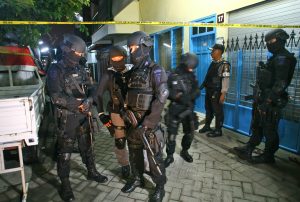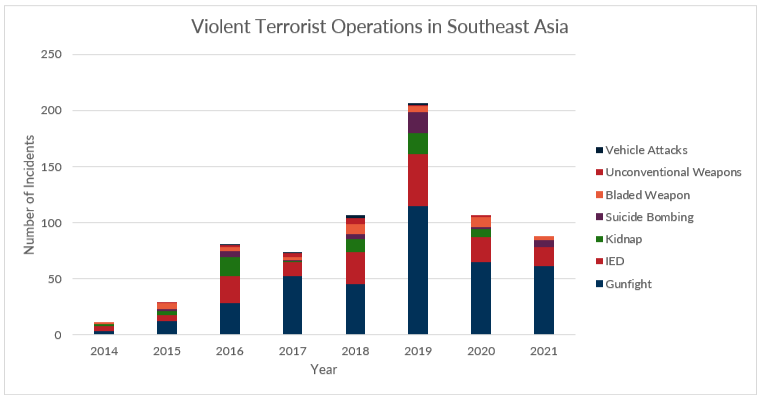Posted to The Diplomat (Apr 15, 2022): As Southeast Asia Reopens, Will Transnational Terrorism Return? (By Kenneth Yeo)
Terrorism in the region has plummeted amid the COVID-19 pandemic. Will reopened borders lead to a resurgence in terrorist networks?
In this late Monday, Jan. 20, 2014 photo, officers of the Indonesian National Police Counter Terrorism Unit Special Detachment 88 (Densus 88) stand guard after a raid on a suspected militants’ hideout in Surabaya, East Java, Indonesia.Credit: AP Photo/Trisnadi
COVID-19, the climate crisis, the coup d’état in Myanmar, the Russia-Ukraine war, and the China-U.S. competition have dwarfed the relative severity of terrorism. Many would struggle to recall a significant terrorist attack during the COVID-plagued years. In a way, terrorism seems out of sight, out of mind.
That is no surprise. In recent years, terrorism in Southeast Asia has been on the decline. Based on the Southeast Asia Militant Atlas developed by the International Centre for Political Violence and Terrorism Research (ICPVTR), S. Rajaratnam School of International Studies (RSIS), the number of violent terrorist incidents peaked in 2019 but experienced a steep decline after the onset of COVID-19 in 2020.

Moreover, terrorist groups in the region, particularly in the Philippines and Indonesia, experienced significant losses at the hands of local authorities. The Armed Forces of the Philippines (AFP) overran terrorist safe-havens, incapacitated terrorist leaders, and pressured many into submission. In Malaysia, the Eastern Sabah Security Command (ESSCOM) eliminated individuals attempting to create a safe haven in Sabah for Abu Sayyaf members fleeing from the AFP. In Indonesia, Densus 88 (D 88), the national counterterrorism squad, has actively disrupted plots, dismantled local terrorist cells, and significantly reduced the frequency of attacks. Overall, active enforcement efforts seemed to have paid off.
Despite efforts to keep terrorism down, terrorist groups continued to express the political will for violence. During the pandemic-plagued years, terrorist groups in Southeast Asia ceased combat operations and kept a lower profile in order to regroup. Analysts noted that this is the practice of i’dad (preparation for jihad), engagement in peripheral activities that strengthen operational capacity. Such activities may include physical training, martial arts, fundraising, weapons procurement and recruitment, inter alia.
Groups like Jemaah Islamiyah (JI) began infiltrating the Indonesian state apparatus, civil society, and academia to champion their political objectives. Notably, Anung Al-Hamat, who is a senior member of Partai Dakwah Rakyat Indonesia (PDRI), an Indonesian Islamist political party, doubled as JI’s top administrator. Anung was also engaged in academic circles and had published a book arguing for mandatory jihadi education in Indonesia.
In the Philippines, the Dawlah Islamiyah-Maute Group (DIMG) has ceased proactive offensive operations and prioritized recruitment. Conditions for recruitment are present. Due to ongoing skirmishes between the AFP and various militant groups, communities became more marginalized and poverty-stricken. While it is unlikely for militants to launch a major offensive in the foreseeable future, signs of regrouping and recuperating are present.
It is thereby evident that extremism will persist. Terrorist groups are doing whatever they can to survive and emerge stronger. Therefore, the momentary lull in attacks must not be misunderstood as the lack of a threat. As globalization is the engine for Singapore’s economy, it is also the lifeblood of terrorism. As such, Singapore Defence Minister Ng Eng Hen accurately assessed that there might be a resurgence of terrorism as global travel resumes. Therefore, while the gradual reopening of borders is celebrated, we must remain vigilant.
Transborder Terrorism in Southeast Asia
Foreign influence amplifies local terrorist attacks. The infamous 9/11 attack in 2001 was planned and coordinated in multiple countries. Khalid Sheikh Mohammed, mastermind of the attack, had communicated extensively with Riduan Isamuddin (alias Hambali), the operational leader of JI, to facilitate the transit of al-Qaida’s operatives through Kuala Lumpur International Airport (KLIA). Hambali continued to facilitate the 2002 Bali bombing, which killed more than 200 people. In Hambali’s confession, he shared that al-Qaida supported him with $30,000 for the attack and rewarded him with an additional $100,000 for the “satisfactory results.”
Organisationally, JI had ambitions to expand its network across the region. While JI was formed in Malaysia in 1993, it shifted its headquarters to Indonesia and created a JI-Singapore. In 1999, JI established the Rabitatul Mujahidin (Mujahidin Coalition) led by Abu Bakar Bashir to create a regional Islamist militant network. This network aimed to pool the resources and expertise of various militant groups. The alliance allowed JI members from Indonesia, Malaysia, and Singapore to train in terrorist safe havens in Southern Philippines.
Foreign Terrorist Fighters
Nonetheless, attacks on local soil are just the tip of the iceberg. The primary concern for the authorities is the migration of foreign terrorist fighters (FTFs).
Southeast Asia experienced three waves of foreign fighting. First, Southeast Asian militants were called to arms during to the Soviet-Afghan conflict. Political scientist Thomas Hegghammer estimated the presence of 5,000 – 20,000 foreign fighters supporting the Afghan mujahideen. Southeast Asians who returned became the “Afghan Alumni;” they leveraged their training and transnational network to organize militant cells and conducted terrorist attacks locally or regionally.
Second, Southeast Asians were drawn toward the Islamic State of Iraq and Syria (IS). After Abu Bakr al-Baghdadi declared the caliphate in July 2014, thousands of FTFs worldwide migrated to Syria to participate in the civil war. Based on the Soufan Center’s 2017 report, more than 53,000 FTFs from 146 countries joined IS in Syria. More than 1,000 were from Southeast Asia, including a Singaporean, Megat Shahdan Bin Abdul Samad alias Abu Uqayl.
Nonetheless, as IS lost ground in Iraq and Syria, it decentralized its organizational structure and created satellite wilayahs (provinces) globally. The Wilayat Sharq Asiyya (East Asia Province) is Islamic State’s easternmost province, which encompasses Southeast Asian countries such as the Philippines, Indonesia, Malaysia, Singapore, and Thailand. IS called for aspiring FTFs to gather in the southern Philippines to besiege the kafir government.
IS’ message was simple; if you cannot travel, take the fight to your backyard.
Ultimately, the mobilization of Islamist militants in 2016 led to the third wave of foreign fighting in May 2017, otherwise known as the Marawi Siege. The five-month siege marked the most devastating war in the Philippines since World War II. Although the Marawi Siege was fought only in the Philippines, it was a regional operation. Besides the combined arms of local terrorist groups like the Maute Group and Abu Sayyaf, another 100 foreigners, including minors, migrated to Marawi to support IS. These FTFs included significant commanders like Malaysians Dr Mahmud Ahmad and Amin Baco.
Returning Foreign Fighters
While foreign fighting occurs abroad, it could be a local problem. The genesis and resurrection of some of the deadliest terrorist groups in Southeast Asia, like the Abu Sayyaf and JI, were connected to al-Qaida through the shared experience of the Afghan mujahideen. The Afghan Alumni, for example, returned with the battle experience and international network to facilitate, organize and conduct attacks at home.
Ignoring FTFs who travelled abroad would be a mistake. However, there is still no consensus among countries on the management of FTFs. Authorities struggle to balance human rights, national security, and government capacity. Today, approximately 700 Indonesians and 100 Malaysians are being detained at Al-Hol Camp or the Al-Hasakah Prison, northeastern Iraq. If the detainees remain unrehabilitated, they can pose a serious security challenge to Southeast Asia.
Regional Safeguards Against Terrorism
Southeast Asian governments recognize that the transnational threat requires a multilateral response. Beyond local enforcement efforts and bilateral intelligence and extradition arrangements, the Association for Southeast Asian Nations (ASEAN) created mechanisms to strengthen its response to transnational terrorism. Transborder terrorism has been a staple in the ASEAN Defense Minister’s Meeting Plus’s agenda.
Targeted subregional initiatives were also established to combat transnational terrorism. For example, the Trilateral Cooperative Arrangement (TCA) implemented in June 2017 aims to curtail violent maritime activities at the Sulu-Celebes Seas. The TCA also doubled as a border-hardening mechanism as the Sulu-Celebes Seas is the primary transit route for FTFs to travel from Malaysia to the Philippines.
The Our Eyes Initiative (OEI) was implemented in January 2018 in response to the 2017 Marawi Siege. Recognizing the role of FTFs in the conflict, several ASEAN member agreed to meet biweekly to exchange intelligence on militant groups and develop a shared database on terrorism. The Southeast Asia Counter-Terrorism Financing Working Group (SEA CTWFG) was launched in November 2019. This working group aims to address transborder terrorism financing by forging a partnership between law enforcement, industry, and academia. The working group comprised the financial intelligence units of the Philippines, Indonesia, and Australia.
What Next?
While other geopolitical events have certainly overshadowed the threat of terrorism, the threat should not be overlooked. As international travels resume, we can expect terrorists to rekindle the flames of war. International terrorist groups may seek to support local attacks, and FTFs with battle experience may seek to return home.
We are not defenseless. Enforcement agencies in the region are doing their part to curtail the rise and spread of terrorism. The region has taken steps to harden borders, enhance intelligence sharing, and curtail terrorism financing. Nonetheless, it is essential for policymakers to update, revitalize, and reboot these multilateral mechanisms to mitigate the risks of terrorism in the region.
[Kenneth Yeo is a research analyst from the International Centre for Political Violence and Terrorism Research (ICPVTR), a specialist center of the S. Rajaratnam School of International Studies (RSIS) based in Singapore.]
https://thediplomat.com/2022/04/as-southeast-asia-reopens-will-transnational-terrorism-return/

No comments:
Post a Comment
Note: Only a member of this blog may post a comment.